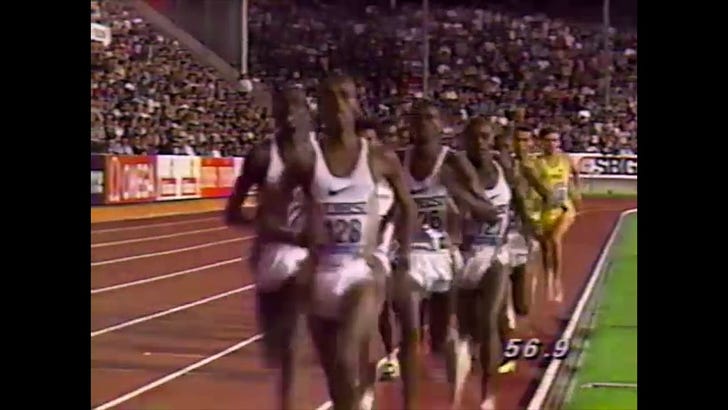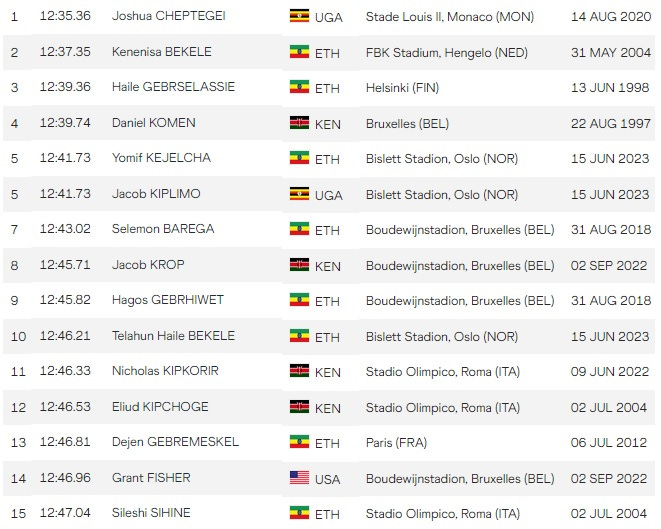None of the three world records set at the Meeting de Paris were as impressive as the Bislett Games men's 5,000 meters
One of those records won't last the summer, but the others may stand for years
As July bled into August in 1995, I was nearing the end of a six-week stint serving the U.S. Government at Fort Sam Houston in San Antonio, Texas and trying to sneak in effective running training at 9 p.m. when it was still over 85 degrees. I wasn’t able to follow much track and field or other news during this sweltering stay, so I’d missed the news that on July 21, Moses Kiptanui of Kenya had missed breaking his own three-year-old world record in the men’s steeplechase (8:02.08) by 1.28 seconds in Oslo. When Eliud Barngetuny ran 8:05.01 in Monaco four days later to become history’s second-fastest man, that had eluded my inactive radar as well.
By August 11, I was back home in New Hampshire. That was when Kiptanui ran a 3,000-meter steeplechase in 8:04.16 in Göteborg, Sweden to again come within range of his world record. Then, on August 16, Kiptanui returned to Zürich and the track where he’d run 8:02.08 three summers earlier and smashed the eight-minute barrier with a 7:59.18. Nine days later, he broke eight minutes again, this time in Bruxelles, but his 7:59.52 just missed his new world record. On September 9, he closed out his season with an 8:02.45 in Monaco, beating Barngetuny by almost five seconds.
Heading into 1996, Kiptanui had the five fastest steeplechase times in history, and he had run four of those in the summer of 1995 alone. The women’s steeple, meanwhile, would not become a World Athletics world-record-eligible event for another four years, and would not become an Olympic event until 2008. But Kiptanui was upset at the 1996 Summer Olympics by countryman Joseph Keter.
On August 13, 1997, Wilson Boit Kipketer (not that Wilson Kipketer) shaved 0.10 seconds from Kiptanui’s WR in Zurich, with Bernard Barmasai (8:00.35) and Kiptanui (8:00.78) both under 8:01. Eleven days later in Köln, Germany, the record moved up at least half a level, with Barmasai blazing a 7:55.72 to Kiptanui’s 7:56.16. In 1999, Barmasai would become the focus of controversy when he admitted to a role in a collusion effort among Kenyans aimed at gaming that year’s Diamond League cash-prize payout.
It would be four years before the event experienced more shaking and stirring. On August 17, 2001, Moroccan Brahim Boulami became the fourth man under eight minutes in the 3,000-meter steeplechase with time of 7:58.50 in Zürich. Eight days later in Bruxelles, Boulami cleanly broke the world record by running 7:55.28, leading Kenyans Rueben Kosgei and Stephen Cherono under eight minutes as well.
On August 16, 2002, Boulami lowered his own world record to 7:53.17 in Zürich. But the mark would never be ratified, because a urine sample Boulami submitted the day before the race tested positive for EPO. Nevertheless, he remained the world record holder until 2004, when Cherono, by then a citizen of for Qatar named Saif Saaeed Shaheen, ran 7:53.68.
To date, only thirteen men are credited with breaking eight minutes in the outdoor steeplechase (no one has come remotely close indoors). One of those dirty baker’s dozen is Lamecha Girma of Ethiopia, who ran 7:52.11 on June 9 at the Meeting de Paris (complete results) to break Shaheen’s musty mark by over one and a half seconds (video).
This was one of three world records set at the Paris meet, where Jakob Ingebrigtsen also stormed to a world-record 7:54.10 two-mile and Faith Kipyegon took down Letesenbet Gidey’s 5,000-meter world record (and Gidey herself) in following the pacing lights to a 14:05.20 (video). Of these three records, Kipyegon’s is easily the most vulnerable. Kipyegon, Gidey, and Sifan Hassan should all be capable this summer of following the lights, human pacers, and each other to the sub-67.2-second laps required to break fourteen minutes.
Of the two new men’s world records, I believe Girma’s is the best overall mark. But it may not outlast Ingebrigtsen’s 2M simply because the latter event is so rarely run. Even if 7:54.10 for two miles is superior to 7:52.11 for a steeple, it’s plain that the former mark has more available challengers c. 2023 than does Girma’s record, the first steeplechase ever run at faster than 63 seconds per 400-meter segment.
Two of those available challengers are Jacob Kiplimo of Uganda and Yomif Kejelcha of Ethiopia, who raced to a dead heat in the 5,000 meters at the Bislett Games in Oslo on June 15 (Kejelcha was awarded the win, but no one cared). With virtually identical times of 12:41.73, the two moved into a tie for the #4 spot on the all-time outdoor list, while Haile Bekele (no relation to Kenenisa Gebrselassie) landed at #10.
Kejelcha and Kiplimo came into Oslo with personal bests of 12:46.79 and 12:48.63, so neither their times not the invisible gap between them at the finish line were total surprises.
Their close finish recalled another epic 5,000 meters that was tighter than the score sheet suggests. On August 14, 1996, Haile Gebrselassie and Daniel Komen squared off in the 5,000 meters at the Weltklasse meet in Zurich. Geb had set the world record a year earlier at the same meet in 12:44.39, with no one else under 13:00 that day, while Komen had run 12:51.60 earlier that summer.
Komen narrowly missed Geb’s record in becoming the second man in history under 12:50, but the race was notable for two other things longtime track fans will remember acutely: Geb’s utter shambles of a final 120 meters (he ran 12:52.70 anyway; at the time, only Komen and Salah Hissou had run faster) and Bob Kennedy—who is probably unrelated to even more famous Robert Kennedys—becoming the first American and ninth human overall to break thirteen minutes for the distance.
The thing that stands out about that shared 12:41.73 is how uneven the pacing was for such an objectively fast effort. Based on Letsrun’s reporting and the official results with splits, the two leaders passed through 3,000 meters on pace to run 12:59, then ran around 4:54.5 for the final 2,000 meters. Alternatively, they passed through 3,400 meters on pace to run 12:57, then covered the last four laps in 3:54.33 (equivalent to a 3:55.7 mile).
A 4:54.5 2,000 meters is, by itself, worth a sub-3:51 mile. JK and YK in ran 3,000 meters at sub-13:00 5,000-meter pace (okay, barely) and then, with no rest at all, ran five laps in an average of 58.9 seconds. There is no question either man could have erased more than half of the gap between Joshua Cheptegei’s world record (12:35.36) and a 60-second-per-lap 5,000 meters (12:30.00) with more even pacing.
There were other great performances at the Bislett Games, including Ingebrigtsen’s 3:27.95 1,500 meters. That time just underscores how incredible Hicham El Guerrouj’s twenty-five-year-old world record of 3:26.00 rally is. Two seconds at that level is an eternity. Also, the older Bernard Lagat’s 3:26.34 becomes without anyone getting close to that time, either, the more obvious it should be to any holdouts that Beaming Bernie was a doper as well as a pure mercenary throughout his entire career. Anyone who believes Nike didn’t steer Lagat away from a well-deserved suspension in 2003 is deluded.
The take-home message is that the men’s and women’s 5,000-meter outdoor world records are vulnerable despite one being almost brand-new and the other fairly fresh. The women’s should be reset by six or more seconds sometime this summer, maybe after the World Championships in Budapest, while the men’s is likely to come down by a little less than that. (Track and Field News keeps a list of the athletics records broken each year, indoors and out, including a running tab of 2023 record-breaking efforts.) And know this: If either record does fall soon, you’re guaranteed to see or hear the news someplace else first.


